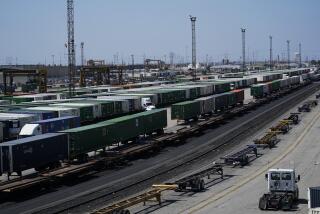EPA targets cement emissions
Environmentalists and industry representatives pleaded their case with federal regulators Tuesday over rules that would slash toxic emissions from cement kilns, the top source of mercury emissions in California.
The Environmental Protection Agency issued proposed regulations for Portland cement kilns earlier this year, after more than a decade of pressure from environmental groups. The rules aim to reduce the industry’s mercury emissions by 81% to 93% annually, as well as cut emissions of hydrocarbons, particulate matter and hydrochloric acid.
The EPA projects that the changes could save billions of dollars and hundreds of lives a year, but cement industry officials say they will drive up the price of cement, and may drive the industry to countries with lower pollution standards.
The rules would “undermine the stability of the domestic cement industry, endangering thousands of jobs and the supply of a basic construction material for uncertain environmental benefits,” Andy O’Hare, a spokesman for the Portland Cement Assn., told EPA officials at the hearing in downtown Los Angeles.
“This regulation will help all Californians breathe easier, particularly the dozens of California communities neighboring cement kilns,” Otana Jakpor, a Riverside high school student speaking for the American Lung Assn., told the EPA panel. “It will reduce hundreds of thousands of tons of toxic chemicals that harm young people. And it will do so with technology that already exists.”
Portland cement kilns, which produce the key ingredient in concrete, account for 90% of the state’s airborne mercury, which can affect the nervous system, cognitive function and kidneys, and can cause respiratory failure and death at high exposures, the EPA says.
Cement kilns emit hazardous chemicals as they burn coal, petroleum coke or industrial waste to heat raw materials including limestone ore, which also can contain mercury and other elements. The process produces “clinker,” which is cooled, ground and mixed with gypsum. In 2008, high levels of a toxic carcinogen were traced to piles of clinker outside the TXI Riverside cement plant, which has since shut down.
California is the nation’s largest producer of cement, and houses 11 of the nation’s 163 Portland cement plants, including the Lehigh Southwest plant in Tehachapi, which has been one of the industry’s worst mercury polluters.
The EPA is accepting public comments on the proposed rules through Sept. 4.
--
More to Read
Sign up for Essential California
The most important California stories and recommendations in your inbox every morning.
You may occasionally receive promotional content from the Los Angeles Times.










